A general birding tour in North Norfolk today, and a mission to study some of the regular ducks, geese and waders that grace us with their presence through the winter months. There was no sign of the forecast ice or snow overnight, and the day dawned cold and windy – but at least it was dry. The forecast was for wintry showers, so we decided to make the most of the weather while it lasted. As we saw yesterday, even when the weather is bad, you can find birds if you get out looking.
We set off west along the coast. First stop was Wells Harbour – we had seen several large flocks of Brent Geese yesterday, but it was good to see some close up today. Several small groups were swimming around in the harbour and loafing around on the muddy water’s edge, preening. We got a good chance to study them – both adults and stripy-backed juveniles. There were also a few waders around – a Bar-tailed Godwit, a Grey Plover, a couple of Ringed Plovers and several Curlew. Unfortunately, nothing else had been blown in on the wind to seek shelter.
 Brent Geese – several small groups were bathing & loafing around the harbour
Brent Geese – several small groups were bathing & loafing around the harbour
Next was Holkham, where we stopped on Lady Anne’s Drive to have a close look at some of the Pink-footed Geese. A small group was feeding on the grass next to the fence, so we got a good chance to study them, too.
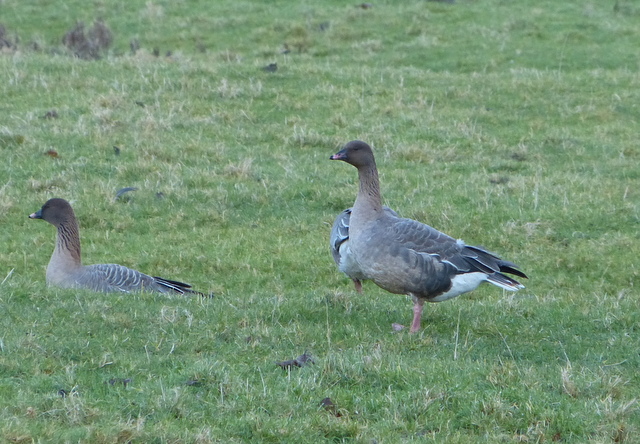 Pink-footed Geese – in their usual place at Holkham
Pink-footed Geese – in their usual place at Holkham
There were lots of other things to see here as well, and for a while the sun even came out. A big group of Wigeon was out on the grazing meadows, as usual, feeding quietly at first but suddenly spooked by something and flying round noisily. There was a good selection of waders here too – a single Black-tailed Godwit, a small mixed group of Redshank and Ruff (great to see them side-by-side, to study the differences), a couple of smart Snipe and several Lapwings. In amongst them all were lots of Fieldfares.
 Lapwing – enjoying the sunshine
Lapwing – enjoying the sunshine
We were just leaving, driving back up the Drive, when a large brown shape in the field by the road attracted attention. Pulling up quickly, it immediately became clear that it was a Marsh Harrier and it was feeding on something. A Magpie waited a discrete distance away, looking on hungrily. We got out carefully and put the scope up – it stayed where it was, looking round nervously all the time between plucking at the prey. We got awesome views of it through the scope. Its golden yellow iris really shone in the sunshine – clearly a male, though probably a young bird with still rather female-like head and body, but some grey showing on the secondaries and a paler tail base. A short video of the bird feeding can be seen here. Simply stunning.
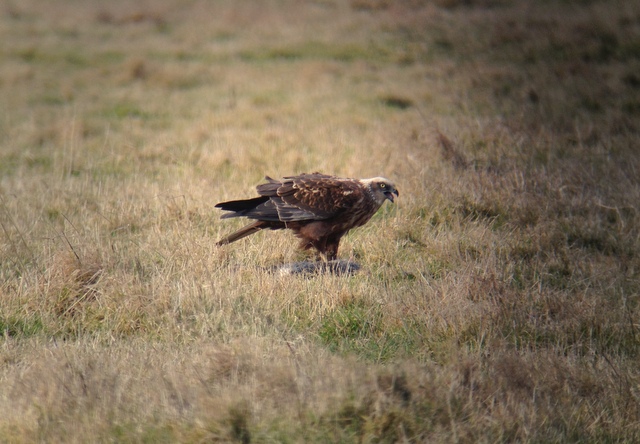 Marsh Harrier – feeding on a dead rabbit by the road
Marsh Harrier – feeding on a dead rabbit by the road
The expanses of Burnham Overy grazing marshes are very exposed to the wind, but eventually we located the Rough-legged Buzzard. It kept dropping down out of view in the dunes, before flying round again, with bouts of distinctive hovering, flashing its black-banded white tail. Apart from a couple of Kestrels and Marsh Harriers, there was little else of note out there in the open.
The plan was to head for Titchwell, but with the weather still holding off, we went straight past and on to Thornham. Out at the harbour, we could see a small group of 5 Twite flying round even before we got out of the car. We got some distant views of them before they settled by the seawall and, by walking round onto it, could see them much better, noting their orange-washed breasts and yellow bills. As we walked round to see them, a wader flew off from the mud and disappeared into one of the creeks – its distinctive ‘tchueet’ call gave its identity away, a Spotted Redshank. Thankfully, as we turned to head back to the car, it had reappeared in the deep water underneath the sluice gate and we were able to get a proper look at it the scope.
 Twite – 5 were still around the harbour today
Twite – 5 were still around the harbour today
The dark clouds were now gathering so we hurried back to the car, just in time as the heavens opened. We headed back round to Titchwell for an early lunch while the rain, sleet and hail battered the car. Thankfully, today it was really showers, so after lunch it abated and we were able to get out onto the reserve.
There were few waders on the drained pool on the Thornham side as we approached, but it didn’t take long to find the Water Pipit out on the mud. We took a good look at it before another squally shower arrived and we made for Island Hide, just as a little group of waders flew in – Dunlin, Knot, Ruff and Black-tailed Godwits.
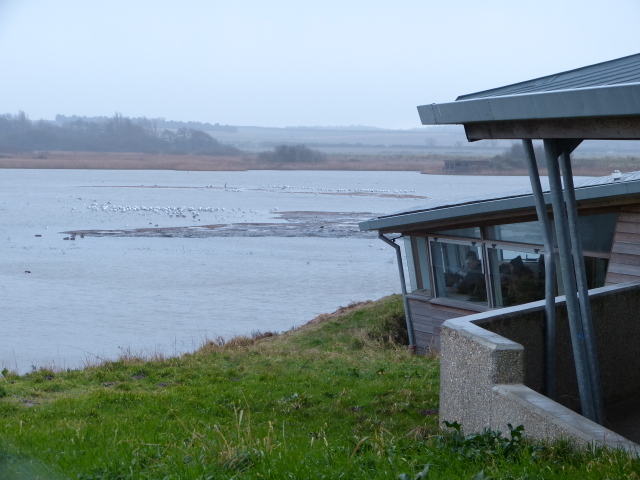 Titchwell Freshmarsh – water levels are still high
Titchwell Freshmarsh – water levels are still high
The water levels on the freshmarsh are still high – good for ducks, but not so good for waders. There were several very smart Pintail – a group of 4 asleep at first, but then 3 swimming out on the water including 2 stunning drakes. We could see their pin-shaped tails in the scope. More Gadwall than previous weeks were present – a subtle-plumaged and consequently under-rated duck – as well as lots of Shoveler, Teal and Mallard, plus a few Wigeon and Shelduck. Still 5 Avocets are lingering, despite the lack of mud, and again they flew round several times as if looking for the muddy islands and channels which are normally there.
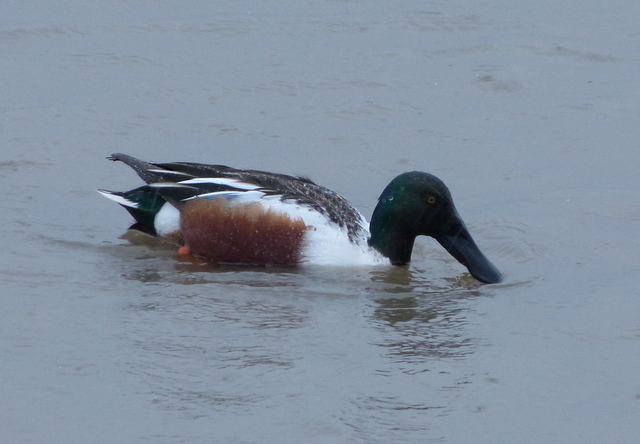 Shoveler – the drakes are looking very smart now
Shoveler – the drakes are looking very smart now
There were also lots of gulls taking shelter from the blustery wind and crashing waves out on the beach. Amongst them, a smattering of waders included several Black-tailed Godwits (one of them sporting a distinctive combination of colour rings), Ruff, Turnstone and Redshank, as well as a couple of Ringed Plover. As the rain started lashing down again, we took shelter in the Parrinder Hide.
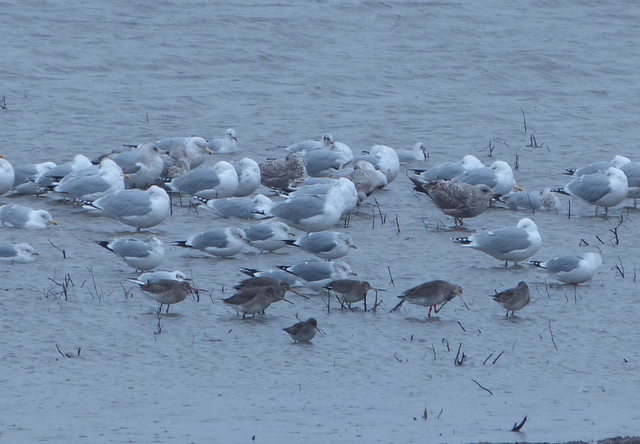 Gulls & Waders – sheltering on the freshmarsh
Gulls & Waders – sheltering on the freshmarsh
 Black-tailed Godwit – with a distinctive combination of colour-rings
Black-tailed Godwit – with a distinctive combination of colour-rings
As usual, there were even more waders out on the Volunteer Marsh – Curlew, Grey Plover and Knot. As the rain eased again, we walked out further along the bank. Another Spotted Redshank was wading in the deep water alongside the path – giving us great views of its distinctive needle-fine bill, much longer than the bill of a normal Redshank.
 Spotted Redshank – in silvery-grey winter plumage
Spotted Redshank – in silvery-grey winter plumage
The tidal pools held a pair of Goldeneye, including a smart black and white bodied, green-headed drake. Lots of Oystercatchers were huddled together on one of the islands and a single Bar-tailed Godwit was feeding in the shallows. We looked at the beach, but the wind was howling in off the sea, the waves were crashing in, and the dark clouds were heading our way again. We beat a hasty retreat.
We were almost back when a ghostly grey shape disappeared amongst the bushes and trees in the reedbed. Flying steadily west, low above the reeds, it reappeared again as it crossed the path and headed out across the grazing marsh towards Thornham – a cracking male Hen Harrier. We could see its black wing tips and white uppertail patch. It turned sharply, dropping down into the grass as a couple of Meadow Pipits exploded from it, before carrying on its way across the reeds and away towards Thornham Harbour.
We went round to Fen Hide next, but there was no sign of any Bitterns and it looked pretty bleak. The highlight was a Sparrowhawk which flashed across close in front of the hide. It was time to call it a day. As we walked back to the car, the weather had one last laugh, as the sun came out again briefly through the clouds!
As we drove back along the coast, there was time for one more nice surprise. A Barn Owl was hunting over an overgrown grass field right next to the road. We watched it flying round, hovering and occasionally dropping sharply into the grass. A lovely way to finish the weekend.
















